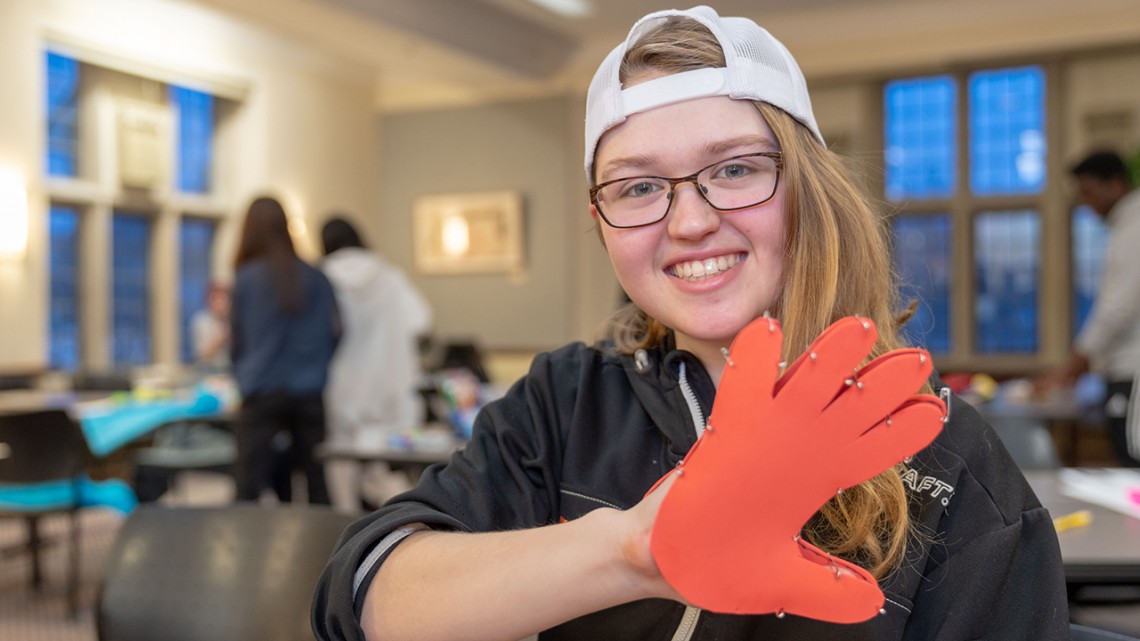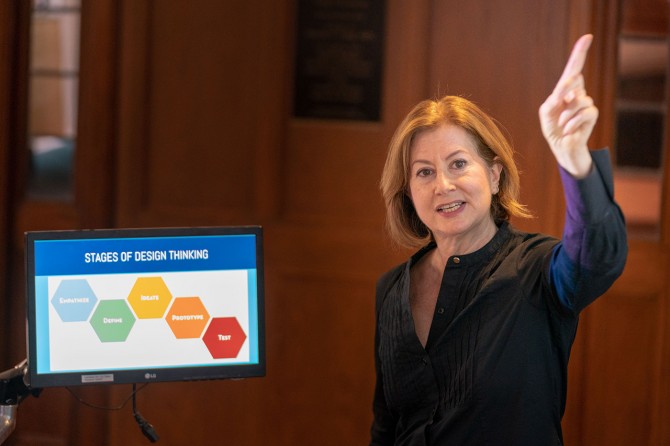
Kira Segenchuk ’22, a student in the Milstein Program, shows off the solution she made using safety pins and foam to simulate a glove.
Workshop teaches problem-solving through rapid prototyping
By Maja Anderson
The process of “design thinking” is a solution-based approach to problem solving and involves five steps: empathize, define, ideate, prototype and test.
On Feb. 20, Diane Levitt, senior director of K-12 education at Cornell Tech, visited campus for a design thinking workshop with community members and students in the Milstein Program in Technology and Humanity. Participants learned how to work as a team to create rapid prototypes, in an attempt to solve real-world problems.
Levitt, who works with individual schools and the New York City Department of Education’s CS4All initiative, teaches this workshop to educators and students of all ages. A foundation of computer coding, the design thinking process helps teams think through complex problems by reframing them in a human-centric way.
During the Cornell workshop, teams worked in groups of three or four with three cards defining a “user,” a “task” and a “constraint.” Levitt explained that one of the most important parts of design thinking is to first understand and empathize with your user, in order to tailor solutions to their needs. The next step was to apply the user’s needs to the task they were given, while considering the constraints placed upon them.
Teams then spent five minutes brainstorming ideas, discussing their ideas and then ranking them by creativity and impact. They then chose the ideas deemed the most creative and impactful to move to the prototyping phase. Using basic office supplies, plus recycled and other materials, the groups then made mock-ups of their solutions. Finally, the groups shared their prototypes and their thinking process behind their creations.
While at first the tasks seemed daunting, the teams quickly set to work to come up with solutions. One group received “mothers” as their user card, “build a home” as their task and “made out of glass” as their constraint. The group decided to interpret “building a home” as home renovations and focused on their user’s needs by devising ways to use glass to child-proof a home. They imagined durable, shatterproof glass stove covers and partitions to prevent young children from entering certain areas of the home.
Another group – tasked with “midlife crisis fathers,” “a way to sit up straight” and “waterproof” – thought up a wearable contraption with a remote control that would allow family members to send gentle reminders to prompt dad to sit up straight.
Teams picked from an assortment of objects including pipe cleaners, plastic containers, boxes, pom-poms and clothes pins to create their sometimes, whimsical prototype designs. After a short dinner break, the teams presented their designs.
“I see computer science as an opportunity to help promote equity. That’s really the reason I do this work,” Levitt said. “For Cornell Tech, teaching computer science to all students is a social justice mission. We focus on access for everyone in everything we do.”
The Milstein Program in Technology and Humanity models integrative, interdisciplinary learning through a liberal arts education in the College of Arts and Sciences with cutting-edge programs and courses for undergraduates at Cornell Tech in New York City.
Maja Anderson is program manager for the Milstein Program in Technology and Humanity.
Media Contact
Get Cornell news delivered right to your inbox.
Subscribe

